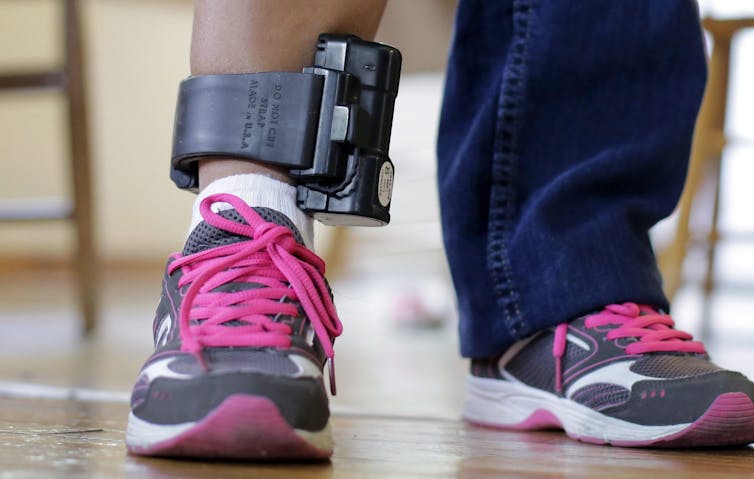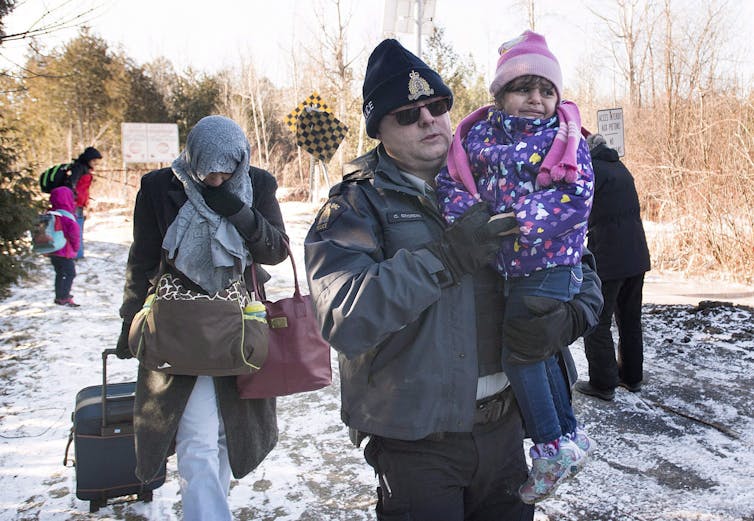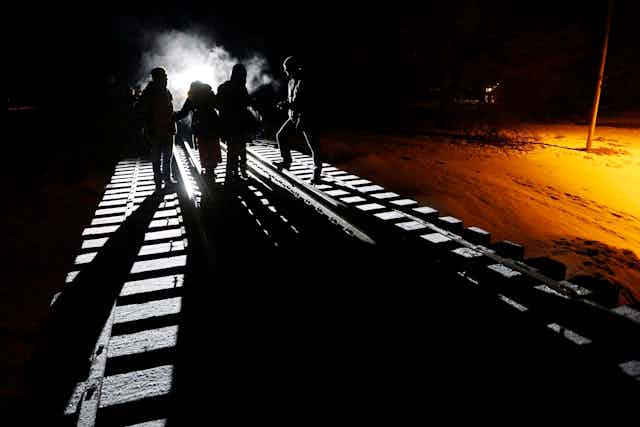The Canada Border Services Agency (CBSA) recently announced its intention to remotely monitor migrants via electronic ankle bracelets as an alternative to detaining them.
This plan is set out in the emerging National Immigration Detention Framework. The idea is to “tag” migrants with the ankle bracelets, which then send GPS signals to a central monitoring station.
Since it’s 24/7 surveillance, the “tagged” migrant can be potentially re-arrested at any time.
A pilot tagging program is slated for Toronto as early as April. A tender has been issued for a private partner to implement it.
While superficially appealing, this program is a step backwards as an alternative to the inhumane practice of detaining migrants, sometimes in provincial jails.
Tagging is meant to capture people who abscond — or purposely evade immigration authorities to live clandestinely — and people who may harm themselves or others.
Yet Canada is a “destination state,” and most migrants who have made the long journey here would prefer to live openly and co-operatively with authorities and their communities.
Research demonstrates that the best alternative is quality support and services to migrants based on their individual needs so that their cases can be resolved in the community, without the use of immigration detention or coercive monitoring practices.
Such “case management” techniques even lead to increased rates of voluntary deportation, a costly problem for Canada where most deportees are “forced to leave with escorts or (have their) transportation costs paid by the government.”

What tagging does do, however, is criminalize, stigmatize and alienate migrants from the community that is meant to be supervising them.
The true alternative to immigration detention is release. Living in the community can be coupled with free access to high-quality legal counsel and social welfare services for a financial cost that is much lower than imprisonment.
By putting forward tagging as an alternative to detention, the CBSA risks compromising its commitment to a new, more humane approach to immigration control in Canada.
Detaining migrants
Immigration detention is the incarceration of non-citizens in order to deal with irregularities in their immigration or refugee claims, or to ready them for deportation.
Immigration detainees are not being held for criminal infractions. Rather, these are civil, administrative legal grounds. The Canadian government detained approximately 6,251 people in 2016-2017, with 439 people being held for more than 90 days.
The detention facilities are in Montréal, Toronto and Vancouver, but the CBSA also transfers people to provincial correctional centres. People who have exhausted their claims to remain in Canada and have been issued deportation orders comprise approximately 80 per cent of the detained population in Canada, with refugee claimants and others making up the remainder.
Immigration detention is a last resort because it harms detainees and their wider networks of friends and family members.
For years following periods of detention, people report depression, demoralization, concentration and memory disturbances, and persistent anxiety, all of which are doubly disturbing in light of the high rates of release back into the community.
In other words, many detainees are never deported, a primary goal of detention. Instead, they are forced to cope with the trauma of incarceration while simultaneously navigating the challenges of settlement and integration into Canadian society.
The National Immigration Detention Framework
Following a string of deaths, increased media coverage, a change in federal government and Canada becoming a partner in the UNHCR Global Detention Strategy, the CBSA committed to reforming its detention system.
The Liberal government under Prime Minister Justin Trudeau is devoting $138 million over five years to developing the National Immigration Detention Framework (NIDF).
The NIDF will address four key issues, including alternatives to detention, in order to create “a better, fairer system that supports the humane and dignified treatment of individuals while protecting public safety.” The other issues pertain to partnerships, mental health and transparency.
The CBSA held stakeholder meetings and issued a call for public consultation, to which I contributed. Subsequently, Public Safety Minister Ralph Goodale issued a national directive aimed at preventing the detention of children.

Goodale also announced negotiations with the Salvation Army and the John Howard Society to provide “supervision and case management services” to former detainees, and to begin electronic monitoring in lieu of imprisonment.
Criminalizing migrants and refugees
These announcements may provoke cautious optimism, but at least three aspects of the tagging proposal should give us pause.
First, these ideas reflect the encroachment of criminal justice norms into the immigration and asylum sector. They are part of the global trend of criminalizing border-crossers. Migrant and refugee rights organizations such as the Canadian Council for Refugees and the International Detention Coalition are adamant that alternatives to detention must never criminalize people.
Yet both the Salvation Army and the John Howard Society, as well as the very concept of tagging, hail from preventive and criminal justice settings.
Tag-wearers commonly view tagging as a punishment or “living under a suspended sentence in itself.” This flies in the face of the justification for detention, which is only legal when it’s administrative, not punitive.
Canada’s earlier experiment with tagging detainees proved disastrous. In the mid-2000s, Canada tagged some men who had been arrested as terrorist suspects under the Security Certificate regime. Documentary filmmaker Amar Wala shows in The Secret Trial 5 how the former detainees and their families were so traumatized by the monitoring that some of the men actually requested a transfer back to prison.
As Correctional Service Canada reminds us, mobile surveillance was never intended to reduce the prison population. So why would we think that it could reduce the immigration detention population, an implicit goal of the NIDF?
There are also too few details about how to measure the success of the pilot. What rate of absconding will be too high? What level of discomfort will be too much?
Toronto is already home to the Toronto Bail Program, Canada’s only full-fledged alternative to detention. This program is itself an offshoot of the criminal bail system. It has been praised by some, but concerns have also been raised relating to its discretionary practices and outsized influence.
There is also the issue of subcontracting aspects of the tagging pilot to a private, for-profit firm.
Finally, and perhaps more significantly, it’s a grave mistake to position tagging as the best-case alternative to detention.
Refugee shelters are a good alternative
Many refugee shelters in Toronto are willing to act as an alternative to immigration detention. These shelters accommodate vulnerable newcomers and employ highly trained staff who can guide migrants through their court procedures.
Why not build on this experienced network of care and responsibility ? Why reinvent the misshapen wheel by creating a tagging apparatus? A more welcoming alternative would result in better outcomes for settlement and, yes, voluntary deportation for those people who have exhausted their appeals to stay in Canada.
What’s more, for decades, Canada has released detainees with little or no fanfare. Research demonstrates “changes in immigration are either not significantly associated or negatively associated with changes in crime rates” in Canada.
By prioritizing alternatives to detention over release, we are being lead to believe that the problem lies with the migrants.
The problem is actually detention in and of itself. We must not let release slip out of view. It’s therefore vital that the NIDF officials not lose sight of release and other less coercive, damaging and stigmatizing possibilities than tagging, and reject electronic surveillance of migrants and refugees as soon as possible.

